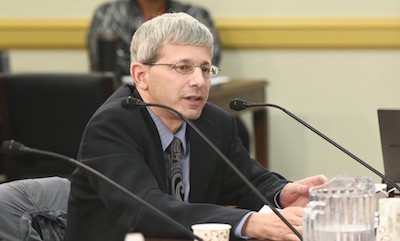Professor Testifies Before Congress on Youth Vaping.

“For the first time in decades, the CDC reports that youth tobacco is significantly rising,” Anna Eshoo, the US Representative from California’s 18th congressional district, said during a legislative hearing of a subcommittee of Congress’ House Committee on Energy and Commerce in Washington, D.C., on October 16. The hearing, to consider sweeping legislation to curb the rise of adolescent vaping, included several expert witnesses, including Michael Siegel, professor of community health sciences. “Our work to end tobacco use and nicotine addiction in the United States is really at risk,” said Eshoo, the committee chairwoman. “We’ve been caught flat-footed by the popularity of e-cigarettes among young people.”
The proposed legislation, titled Reversing the Youth Tobacco Epidemic Act (H.R. 2339), would raise the age for buying nicotine products to 21, regulate the sale of vaping products to be more like cigarette sales, further limit advertising, and ban all flavored nicotine products—from menthol cigarettes to mango Juul pods.
Siegel, a longtime anti-tobacco advocate, voiced his support for the bill, with the exception of the ban on flavored e-cigarette products.
He expressed two key concerns. First, he said that a flavor ban would fail to address the black market e-liquids that are behind the recent spate of vaping-related lung injuries and deaths, and could lead more youth to such black market e-liquids for their flavors, he argued. He also said that losing flavors could make e-cigarettes less effective as an alternative to traditional cigarettes for adults, causing adults to switch back to smoking.
Instead, Siegel argued, legislation should focus on nicotine content and formulation, which he called the real cause of the youth vaping epidemic. While flavors appeal to young people and play a role in them trying vaping, he argued, the issue is how addictive Juuls and other products are. “This is why so many youth are now becoming addicted to vaping,” he said.
“It’s not the flavors. It’s the nicotine.”
Siegel explained that, while most attention has been on how many youths vape, what is more significant is how much they vape. Juul and similar products use a nicotine salt at very high concentrations, while most other e-cigarettes on the market do not use nicotine salts and generally have half the nicotine concentration. “The use of nicotine salts allows the nicotine to be absorbed into the bloodstream much more quickly, simulating the pattern you get with a real cigarette,” Siegel said. After these new products came out, the proportion of youth vapers who vaped every day tripled. Vaping went from something that kids did occasionally and socially to the addiction seen today, he said.
He urged the subcommittee to consider these different formulations when creating regulations for nicotine content in vape pods, with lower limits for nicotine salts, and to require manufacturers to make it clear to consumers just how much nicotine they are actually taking into their bodies.
The Food and Drug Administration (FDA) has been “sleeping” on the issue of e-cigarettes for nearly a decade, Siegel testified. “Had they implemented safety standards back in 2013 when I was first calling for it, we would have had limits on nicotine levels and Juul would never have occurred.”
Joseph Kennedy III, US Representative for Massachusetts’ 4th district and a member of the subcommittee, asked the witnesses what they each thought was the single most important action to take on youth vaping. “It’s regulating the nicotine levels,” Siegel said.
In addition to Siegel, the subcommittee heard from Dorian Fuhrman, cofounder of Parents Against Vaping e-cigarettes (PAVe); Phillip Gardiner of the Tobacco Related Disease Research Program at the University of California; Matthew L. Myers, president of the Campaign for Tobacco-Free Kids; and Susanne E. Tanski, a member of the American Academy of Pediatrics.